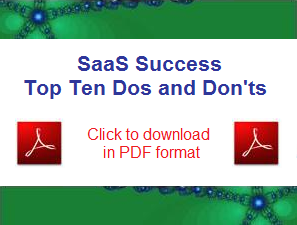
Save it or share it with a colleague.
Click the image above to download the SaaS Top Ten PDF.
For more SaaS business strategy tips,visit or subscribe to Chaotic Flow by Joel York
Or, click below to read the SaaS Top Ten Dos and Don'ts online...
SaaS Do #1 - Choose a Large Market
SaaS Do #2 - Create a Hub on the Web
SaaS Do #3 - Accelerate Organic Growth
SaaS Do #4 - Craft a Compelling Story
SaaS Do #5 - Build the Business into the Product
SaaS Do #6 - Reach across the Firewall
SaaS Do #7 - Monetize Creatively
SaaS Do #8 - Enable Mass Customization
SaaS Do #9 - Open Up to the Cloud
SaaS Do #10 - Leverage Your Community
SaaS Don't #1 - Chase Elephants
SaaS Don't #2 - Waste Money Marketing Offline
SaaS Don't #3 - Launch without Online Trial
SaaS Don't #4 - Cover up Shortcomings with People
SaaS Don't #5 - Invest in Channel Partners too Early
SaaS Don't #6 - Bleed Cash Indefinitely
SaaS Don't #7 - Ignore the Long Tail
SaaS Don't #8 - Think You Can Control It
Software-as-a-Service
Success
The Top Ten Dos and Doníts of SaaS Business Success
Anyone old enough to remember the reengineering craze of the early nineties may recall that this was a monumental shift in thinking about how to apply new technology to business centered on redesigning business processes for order-of-magnitude gains in productivity. The basic ideas were codified in the book: Reengineering the Corporation by Michael Hammer and James Champy. Brainstorming and out-of-the-box thinking were the order of the day, because creativity was the key ingredient to realizing the potential gains. However, creativity has not been the mantra of the SaaS revolution, the mantra of SaaS has been lowering TCO (total cost of ownership). Basically, take what is already done, make it multi-tenant, deliver it over the Web, aggregate customers and offer it for less. While this is a great business proposition for customers, it places SaaS vendors squarely into highly-competitive, price-sensitive commodity markets.
If you want to differentiate your offering, you must look beyond the client-server application that you are replacing and enable order of magnitude productivity gains in core business processes by connecting your SaaS offering to the rest of the Web. These opportunities tend to arise less from internal processes (the traditional realm of enterprise software), than they do from internal-external and purely-external processes. While 90ís style reengineering was about employee productivity gains, SaaS and cloud-based reengineering will center on order of magnitude productivity gains in prospect, customer, partner, community, and computer-to-computer interaction derived from integration, network effects, user-generated content, and on-demand processing and data.
The poster child for this concept is Google AdWords, easily the most successful B2B application on the Web. Google AdWords is rarely classified as a software-as-a-service, because it doesnít look like a traditional enterprise client-server application, such as CRM or ERP. However, it completely revolutionized the core business process of demand generation for many companies by reaching across the firewall. In this sense, it is no different from an on-demand email marketing tool, which most people have no difficulty labeling as SaaS.
If you think outside-the-box, or rather outside-the-firewall, do you see opportunities to reach out across the Web to your prospects, your customers, your customersí prospects, your partners and your partnersí customers? Can you envision entirely new killer applications that completely redesign a core business process for order-of-magnitude gains in productivity? If you can, then you have taken the first step toward breaking out of the mainstream SaaS hard life of low cost-based competition to the Web world of innovation, differentiation and competitive advantage.